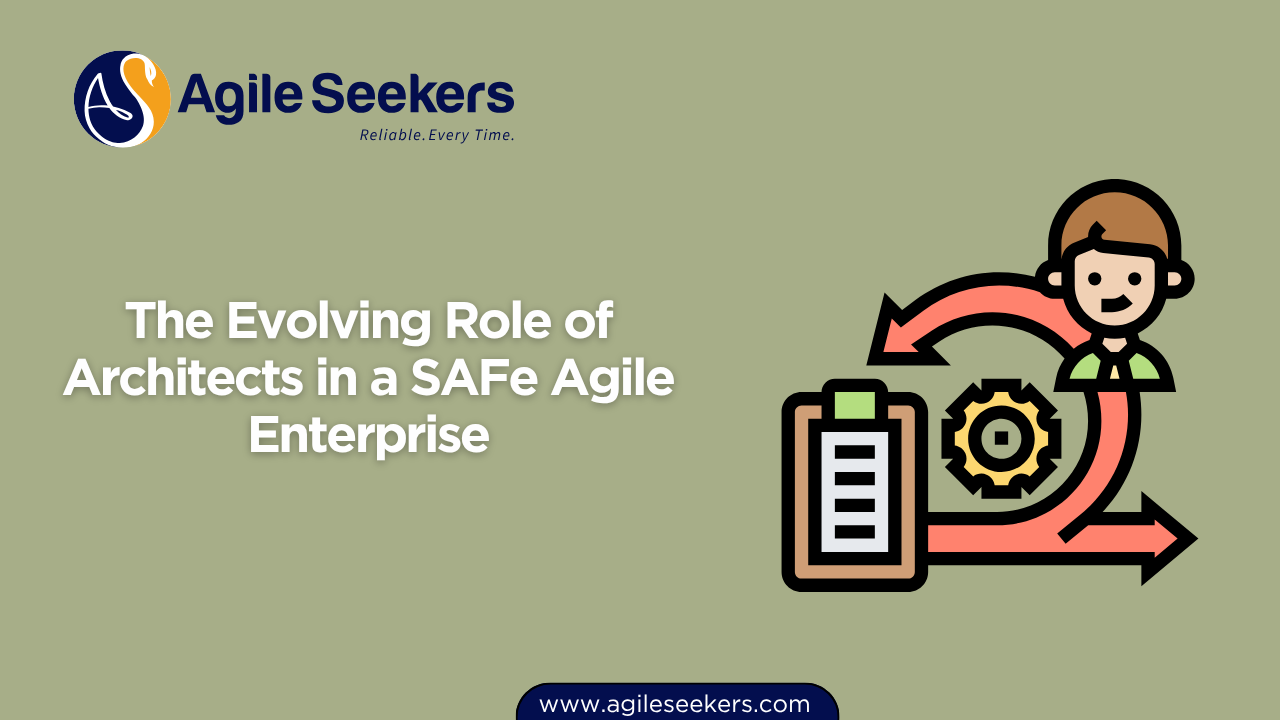The Evolving Role of Architects in a SAFe Agile Enterprise

The role of architecture and architects in SAFe has changed significantly. Traditional models often placed architects in a command-and-control position—making top-down decisions, handing off designs, and being seen as gatekeepers. But in a SAFe Agile enterprise, architects are expected to lead differently. They enable flow, collaborate deeply with teams, and align technology strategy with business goals.
Let’s explore how this shift transforms the architect's responsibilities, behavior, and impact in Lean-Agile organizations.
From Directive Authority to Enabling Leadership
Classic architecture was centralized, with architects reviewing designs, approving technologies, and defining the structure of systems before teams could begin delivery. This approach often caused delays, bottlenecks, and rigidity.
In a SAFe environment, architects act as enablers, not controllers. They provide guidance, clarity, and technical direction, but teams retain autonomy. Architects align architecture with the evolving needs of the enterprise, guiding instead of dictating.
This aligns with Lean and Agile leadership principles, where decisions are decentralized, and those closest to the work are empowered to act. Architects now spend less time on approvals and more time coaching and collaborating with Agile Teams.
The New Responsibilities of Architects in SAFe
The Scaled Agile Framework defines three architectural roles:
-
Enterprise Architect – Focuses on strategic direction and long-term technology vision.
-
Solution Architect – Works across ARTs to coordinate capabilities and complex solutions.
-
System Architect/Engineer – Supports teams within an Agile Release Train (ART), driving local decisions and implementations.
Across these roles, SAFe architects:
-
Collaborate with stakeholders to align business and technology objectives.
-
Participate in PI Planning and backlog refinement to ensure architecture supports business priorities.
-
Enable continuous delivery by supporting DevOps and Release on Demand capabilities.
-
Build the Architectural Runway to support future features without delaying teams.
-
Foster emergent design, balancing it with intentional architecture.
Each responsibility demands a mindset of servant leadership and systems thinking.
Recommended reading from SAFe Framework on Architect Roles in SAFe.
Architecture as a Flow Enabler
One of the core shifts in SAFe is optimizing for flow efficiency rather than resource efficiency. Architects play a critical role in removing technical impediments, simplifying system design, and reducing batch sizes.
For example, rather than requiring formal design reviews before coding begins, architects participate in ongoing, informal architecture conversations with Agile Teams. They join ART syncs, inspect increments, and ensure the Architectural Runway evolves to meet new demands.
This proactive engagement supports a continuous delivery pipeline, which is central to achieving Release on Demand.
You can learn more about how this connects to delivery pipelines in our SAFe Release Train Engineer Certification Training program.
Balancing Emergent and Intentional Architecture
SAFe recognizes the need to balance:
-
Emergent design, which comes from iterative team collaboration and feedback.
-
Intentional architecture, which provides consistency, scalability, and alignment.
Architects help ensure that while teams explore and innovate, they don’t diverge so much that the system becomes incoherent or unscalable. They act as custodians of the big picture, curating reference architectures, maintaining technology roadmaps, and ensuring compliance without blocking progress.
This adaptive balance is also emphasized in the Leading SAFe Agilist Certification Training, where enterprise-wide agility requires flexibility and strategic alignment.
Architects as Partners to Product and Scrum Roles
Rather than working in isolation, architects in SAFe partner closely with:
-
Product Managers and Product Owners, ensuring architecture enables business capabilities.
-
Scrum Masters, supporting team-level execution and identifying impediments to flow.
-
RTEs and Solution Train Engineers, ensuring architectural consistency across multiple ARTs.
This collaboration is central to SAFe’s dual operating system, where hierarchy supports the network of teams that deliver value.
Architects are expected to engage regularly in ceremonies like PI Planning, System Demos, and Inspect & Adapt workshops. Their presence provides real-time technical input and helps teams make architectural decisions with confidence.
For a deeper understanding of this dynamic, explore the SAFe Product Owner/Product Manager (POPM) Certification, which shows how POPMs and architects align on solution intent and priorities.
Embedding Architecture in SAFe Events
Architects play key roles in these events:
-
PI Planning – Present architectural vision, identify enablers, and support capacity allocation.
-
Backlog Refinement – Provide architectural context to help size features and stories.
-
ART Syncs – Surface architectural dependencies and risks early.
-
System Demos – Evaluate built solutions and provide architectural feedback.
This active participation ensures architecture is not a phase, but an ongoing activity integrated within the flow of value.
The ability to guide teams while working alongside them is further developed in the SAFe Advanced Scrum Master Certification Training, which reinforces team-of-teams collaboration.
Evolving Mindsets and Skills
To thrive in this new role, architects must evolve their:
-
Mindset – From “authority” to “enabler,” from “gatekeeper” to “collaborator.”
-
Skillset – Beyond technical depth to include facilitation, coaching, and stakeholder management.
-
Toolset – Leveraging Agile modeling, architecture decision records (ADRs), and system thinking tools to guide teams effectively.
Many architects benefit from learning coaching techniques to influence without control, a capability aligned with advanced SAFe roles and the SAFe Scrum Master Certification program.
Closing Thoughts
SAFe architects are no longer just system designers—they are collaborative leaders who enable agility across the enterprise. Their work bridges business strategy and technical execution, fosters flow, and helps Agile teams innovate at scale.
As technology becomes more central to every business, architecture becomes a shared responsibility. But architects still play a vital role: not by making every decision—but by ensuring every decision aligns with the broader system goals.
To explore how architects support value delivery in ARTs and how their leadership shapes agile transformation, consider learning more through the Leading SAFe and SAFe RTE Certification.
Also read - Designing for DevOps and Release on Demand in SAFe
Also see - Why Lean-Agile Architects Focus on Flow, Quality, and Business Alignment




















